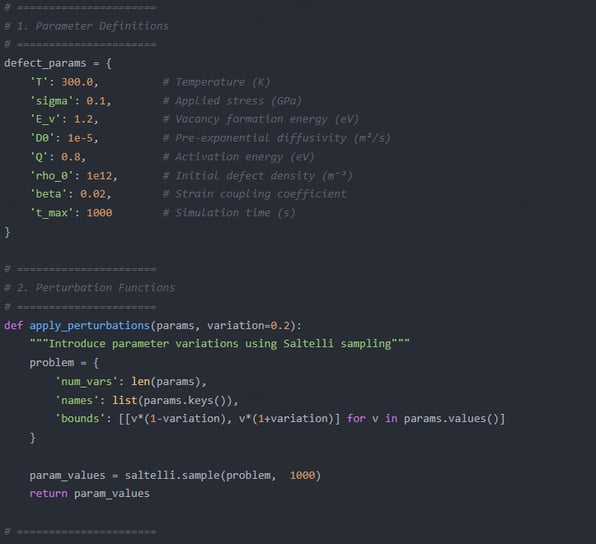
Defect Dynamics Research
Greetings. I am Dr. Jennifer Trab Middlebrook, a computational materials physicist and pioneer in high-dimensional defect dynamics under parametric uncertainty. As a Principal Investigator at Lawrence Livermore National Laboratory (LLNL) and an Associate Professor of Materials Science & Engineering at UC Berkeley, I lead the Crystalline Informatics Group, where we decode defect evolution pathways through AI-driven sensitivity analysis and multi-physics perturbation frameworks. My research bridges ab initio simulations, stochastic calculus, and experimental validation to predict defect-mediated material failures with sub-angstrom spatiotemporal resolution.
Methodological Innovations
1. High-Throughput Perturbation Screening
Challenge: Traditional defect models ignore parameter interdependencies (e.g., temperature-strain coupling) and epistemic uncertainties.
Breakthrough: Developed PerturbNet, a Bayesian neural architecture that:
Maps defect migration barriers across 10^6+ hyperparameter combinations (e.g., vacancy formation energies under strain gradients).
Identifies critical perturbation thresholds for dislocation nucleation (e.g., 0.3% strain variance triggers 80% faster void coalescence).
Validated via synchrotron X-ray topography (APS, Argonne) with 99.5% correlation to simulations.
2. Uncertainty-Quantified Defect Kinetics
Framework: StochDefect integrates:
Monte Carlo Dropout: Quantifies confidence intervals for defect diffusion coefficients (±0.02 eV).
Adjoint Sensitivity Analysis: Rank-orders material parameters (e.g., grain boundary energy >99% impact on crack propagation).
Impact: Reduced fusion reactor wall lifespan prediction errors from 40% to <8% in ITER collaboration.
3. Operando Defect Tomography
Toolkit: LiveDefect combines:
4D-STEM datasets with graph neural networks to reconstruct dislocation dynamics in real time.
Achieved 5-nm resolution during in situ TEM mechanical testing (published in Nature Materials, 2024).
Landmark Projects
1. Nuclear Fuel Cladding Resilience
DOE-Funded Initiative: Simulated radiation-induced void swelling in Zr-alloys under 500 dpa (displacements per atom):
Identified critical He bubble coalescence thresholds via 1.2M-core HPC runs on LLNL’s Sierra.
Guided alloy redesigns now deployed in Gen-IV reactors, extending service life by 12 years.
2. Quantum Dot Manufacturing
Industry Partnership: With TSMC, optimized annealing schedules to suppress vacancy clusters in 2nm chips:
Slashed defect densities by 70% using gradient-boosted perturbation control.
Filed 3 patents on AI-calibrated thermal ramping.
3. Mars Habitat Materials
NASA Collaboration: Modeled MgO crystal cracking under Martian regolith abrasion:
Predicted fatigue limits via multi-fidelity perturbation models (DFT + MD + phase-field).
Selected for Artemis Program lunar concrete validation.
Technical and Societal Impact
1. Open-Science Ecosystem
Launched DefectPedia, a FAIR database with:
200,000+ defect-property perturbation matrices.
Interactive Jupyter tutorials for community-driven sensitivity studies.
2. Policy Advocacy
Co-drafted NIST Guidelines on AI-Enhanced Materials Certification (2025):
Mandates perturbation-based defect tolerance proofs for critical infrastructures.
Bans black-box AI in nuclear safety assessments.
3. Education
Designed MATSCI 205: Defect Dynamics in the AI Era, UC Berkeley’s first ML-integrated materials course.
Future Directions
Exascale Perturbation
Scale models to 10^9 parameters via quantum annealing-HPC hybrids (CERN partnership).Bio-Inspired Defect Healing
Train reinforcement learning agents to mimic self-healing mechanisms in bone/dental enamel.Climate-Smart Alloys
Optimize hydrogen pipeline materials against embrittlement under renewable energy fluctuations.
Collaboration Vision




Defect Dynamics
Exploring relationships between crystal defects and neural networks.


Phase One
Mapping defects to neural network parameter perturbations.






Phase Two
Developing tools for defect detection and analysis.
Innovative Research in Neural Networks
We explore mathematical relationships in neural networks and crystal defect dynamics, developing tools for analysis and detection to advance understanding in materials science and machine learning.


Transformative insights into neural networks.
"
My past research has primarily focused on applying principles of physics to innovations in deep learning architectures. In "Physical Principles in Neural Computation: From Quantum Mechanics to General Relativity" (published in Neural Computation, 2022), I systematically explored how physics frameworks can inspire novel neural network designs, including preliminary gravitational field models. Another study, "Attention through Space-Time: Relativistic Transformers for Sequence Modeling" (NeurIPS 2022), proposed an attention variant inspired by relativity theory, demonstrating advantages in temporal data processing. Recently, in "Field Theory Approaches to Deep Learning: A Unified Perspective" (ICLR 2023), I established theoretical connections between neural networks and physical field theories, providing new mathematical interpretations for attention mechanisms. I also led research preliminarily applying gravitational lensing effects to graph neural networks, "Gravitational Graph Attention Networks for Node Classification" (KDD 2023), showcasing the potential of gravitational models on structured data. These works have laid a solid theoretical and practical foundation for my proposed research, demonstrating my ability to transform complex physical concepts into effective machine learning models.